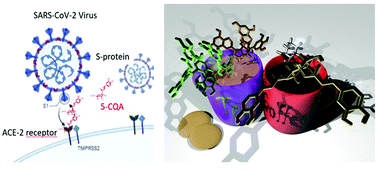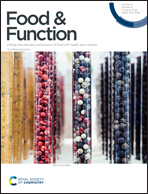Investigating the interaction between dietary polyphenols, the SARS CoV-2 spike protein and the ACE-2 receptor†
Abstract
The global spread of the severe acute respiratory syndrome coronavirus 2 (SARS-CoV-2) has called for an urgent need for the identification of compounds able to control, prevent or slow down the global pandemic. Several dietary polyphenols were assayed against binding to the SARS CoV-2 S1 spike protein and the human ACE-2 receptor, the target of the SARS CoV-2 virus using nano differential scanning fluorimetry, suggesting interaction of dietary polyphenols with both proteins. Following this initial screening the two dietary polyphenols with the strongest affinity were evaluated in a second functional binding assay. The assay was based on the thermophoresis of a fluorescently labelled spike protein and the ACE-2 receptor in the presence of dietary concentrations of the polyphenol in question. It could be experimentally shown that 5-caffeoyl quinic acid and epicatechin reduce the binding constant between SARS CoV-2 spike protein of the alpha variant and the ACE-2 receptor by a factor of ten. The finding could as well be applied to black tea and a coffee beverage with dietary 5-CQA concentrations for the alpha variant Spike protein. Hence it can be speculated that a cup of coffee reduces binding of the virus to its human target, therefore reducing the likelihood of infection with SARS CoV-2, acting as a virus entry-inhibitor.

- This article is part of the themed collection: International Conference on Polyphenols and Health (ICPH2022) special collection


 Please wait while we load your content...
Please wait while we load your content...